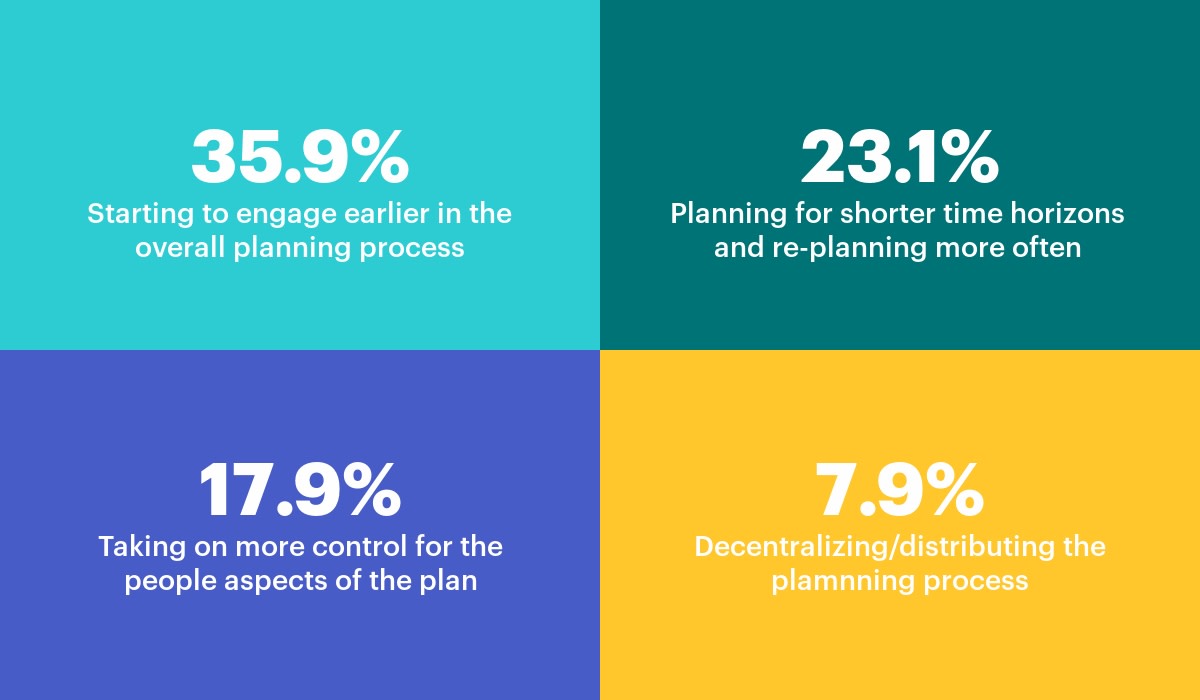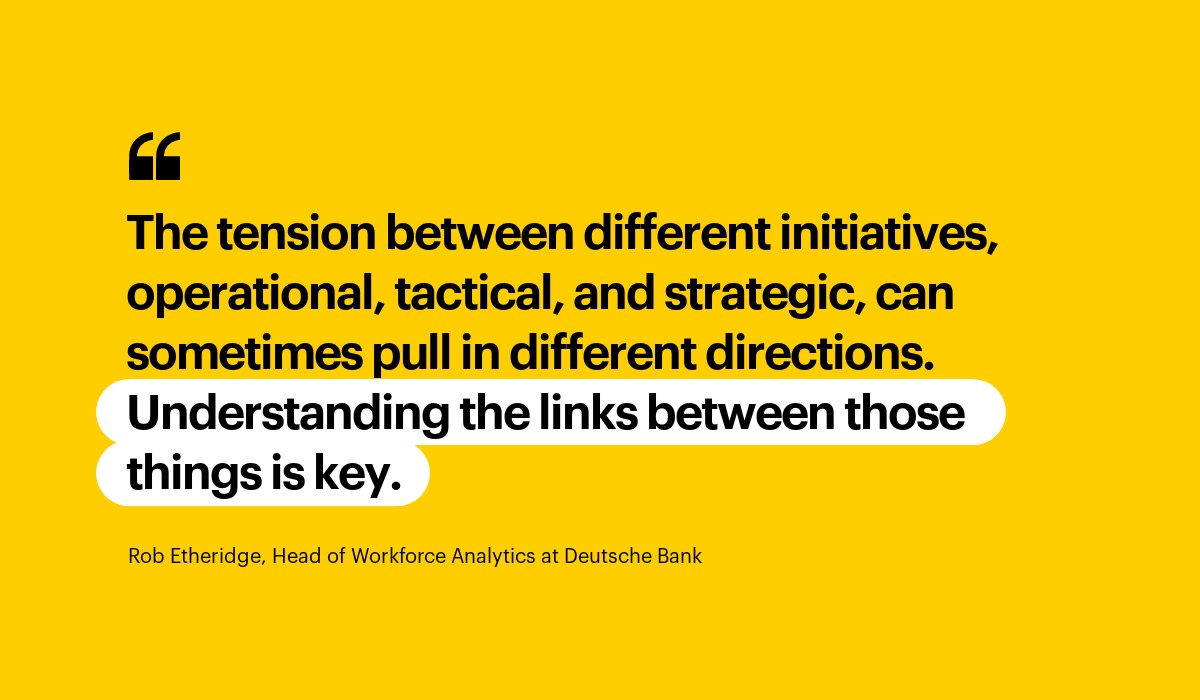Evolution or Extinction: 4 Ways to Make Your Workforce Plans Future-Ready
How are companies evolving their workforce planning strategy to meet today’s challenges? Here are four ways to make your plans future ready.

The workplace has never been on such shifting sands. The pandemic has radically disrupted organizational models and the labour market, and there’s extreme uncertainty around what the future holds.
Workforce planning is one of the best levers to navigate this unpredictability, but the traditional approach—which is owned by Finance, cost-driven, and happening only once a year—isn’t fit for a world that’s changing fast, and going to continue doing so.
During the recent People Analytics World webinar on agile planning, we asked attendees how they were evolving their approach to meet today’s challenges. They said:
Starting to engage earlier in the overall planning process (35.9%)
Planning for shorter time horizons and re-planning more often (23.1%)
Taking on more control for the people aspects of the plan (17.9%)
Decentralizing/distributing the planning process (7.7%)

Let’s explore those responses and share some practical steps to start making progress.
1. Engage earlier in the planning process
“Traditional workforce planning is driven by Finance, who plan according to their annual budget cycle and according to units of cost—assumed to be a specific person in a specific role,” Visier VP of People Analytics, Ian Cook, explains.
This top-down approach sees HR waiting for headcount and cost budgets before engaging with strategic planning. It prioritises financial reporting over workforce outcomes, treating people as a cost centre—and 36% of respondents are ready for a new approach.
Ian emphasises the need for HR to engage earlier, starting by building a detailed understanding of how the organization functions and the movement of people into, out of, and within the business. This total workforce view should include contingent and gig workers, not just FTEs—and it should be nuanced and granular, focussing on skills as opposed to job titles.
As Melissa Kantor, VP of People Analytics and Insights for LEGO puts it, “knowing your current skills breakdown helps you decide what your workforce should look like. Which skills do you want to invest into internally? Which skills are you happy to outsource? Which can you automate?”
It’s also crucial to galvanise finance’s buy-in for this new collaborative and flexible approach. Ian says, “building a precise and detailed picture of your actual organizational situation leads to a far more precise and detailed understanding of the possible future organizations and paths to get there. It provides insights the Finance team don’t have, supporting HR’s case for separating spend limits from headcount budgets.”
2. Increase planning frequency and shorten planning horizons
Businesses today operate in a landscape of extreme volatility, which the pandemic exacerbated. Stela Lupushor, Founder and Chief Executive Re-framer at Reframe.Work predicts the past 18-months’ changes in customer and employee expectations, preferences, and behaviour will be lasting ones. In this context—as 23% of our respondents agree—agile planning is an urgent priority.
“Meeting these changed expectations takes different thinking from an organizational perspective,” Stela says. “How do you deliver? How do you structure your supply chain? How are your skills needs changing? How do you meet those changing needs, as what employees want and need also changes? The current situation creates and perpetuates the need for adaptability and agile planning—to ensure you have the right resources to deliver on promises to clients.”
Traditional annual planning happens too infrequently to accommodate agility—
meaning the data that decisions are based on is usually out-of-date. “The traditional annual planning process is just not fast enough,” Melissa agrees. “We’re asking, what can we do instead of getting locked into yearly headcount frames and bureaucratic approval processes for additional headcount? We need to quickly and agilely pivot our headcount plans, understand our estimate process, and make updates throughout the year.”
Ian suggests an 18-month time horizon with a quarterly review and re-statement at least every six months, using scenario modelling to plan ahead: “Better visibility over your workforce data means you’re making decisions based on an up-to-date picture of the organization and including all known dynamics.”
3. Take more control over the people elements of workforce planning
This point—raised by 18% of our poll respondents—comes back to the need for a more collaborative model of workforce planning. Melissa, for example, believes agile workforce planning would be impossible without “the three musketeers working extremely closely together—people planning, financial planning, and strategy.”
Stela carries this logic further, pointing out how sophisticated workforce planning ultimately demands a whole business view that accommodates both upstream influences and downstream impact of workforce plans. For example, when considering space planning and supply chain planning.
Workforce planning is sometimes seen as very mechanistic, but Stela cautions against detaching planning activities from the people it represents and impacts. Taking workforce planning from strategy to operational execution means recognising the employee experience layer that sits across every decision.
Stela remembers a pandemic preparedness project she was involved with in 2006, for example, which “forced conversations across multiple business units, to really identify—Who are our essentials? What processes have to happen? How do we maintain service delivery without compromising quality or worker safety? This project created a different organisational model and way of supporting customers that could also account for our workforce’s experience and needs.”
4. Decentralize the planning process
Workforce planning realises most value when it empowers better everyday decision-making—that is, daily decision-making that’s aligned to the organisation’s overarching strategic goals.
What that’s really about, Deutsche Bank’s Head of Workforce Analytics Rob Etheridge outlined at Experts at Work: Human Capital Analytics—Unlocking Workforce Planning, is connecting strategic, tactical, and operational decisions. For Rob, workforce planning must become “a bridge—connecting parts of the business and allowing more granular distributed decision-making.” As 8% of our respondents identified, that hinges on decentralizing planning.
Ian summarises the ideal approach: “Ideally, Finance sets cost limits so each business unit knows how much they can spend on people—but without prescribing headcount. From here, each team or business unit leader scopes out how people could best get the work done. They don’t make one plan but several, so they have an understanding of how to adjust to real business conditions.”
This decentralised model rests on having the freedom and flexibility to make headcount decisions at operational and tactical levels. A warehouse manager, for instance, is better placed than Finance or HR to know whether productivity needs are best met by three more junior FTEs or one more senior FTE for the same cost.
Rob further underlines the importance of decentralising planning to create visibility, to ensure initiatives aren’t at odds with one another. “The tension between different initiatives, operational, tactical, and strategic, can sometimes pull in different directions. Understanding the links between those things is key.”

He shares the example of an initiative to improve recruitment diversity running in parallel to an initiative to reduce costs by reducing attrition and improving internal mobility. Both laudable aims, but success with the latter is actively counterintuitive to the first as it’ll reduce hiring needs.
Decentralising and integrating planning creates organisation-wide visibility that enables the business to align resources appropriately and efficiently, prioritising initiatives towards one strategic direction.
HR as agility enablers
To navigate an environment of extreme uncertainty, planning must be agile; able to adapt fast to change. The traditional model of annual Finance-led, cost-driven workforce planning is too reductive and slow.
Driving change is a data, technology, and process challenge. As Rob puts it, “HR are on the hook for enabling the business to get to the answers it needs. As a business partner, you’re not choosing who to hire, who to fire, who to develop—what you are doing is making sure the business is enabled to do those things.”
Get Outsmart content straight to your inbox
Subscribe to the People Insights Monthly newsletter for actionable insights and stories.
Subscribe now